A Koraci, a Dulbian and a Zorcon walk into a bar…
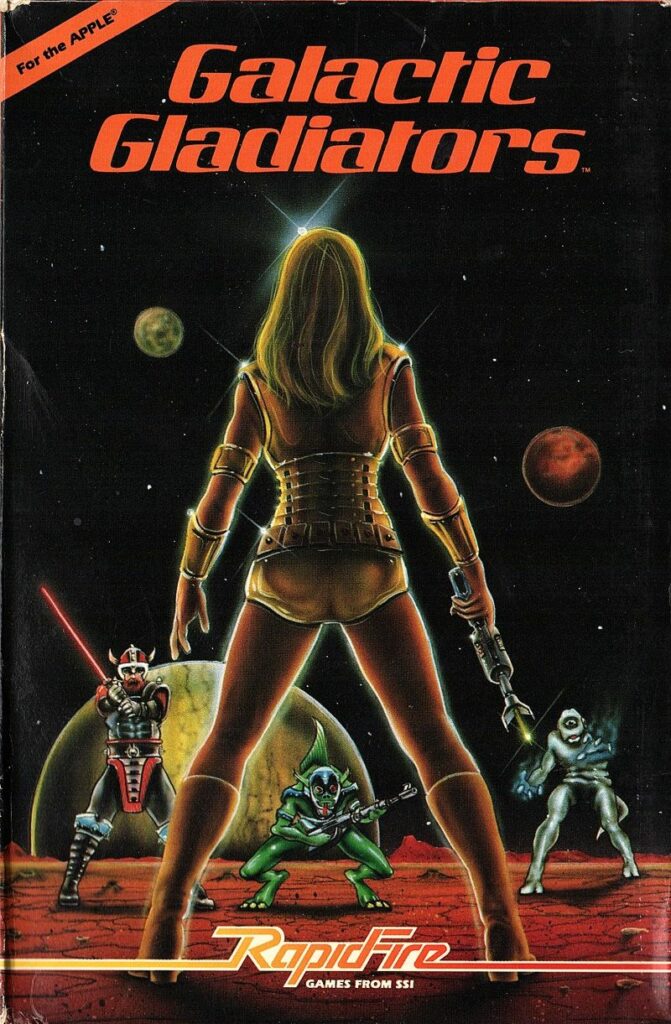
In late 1981 or 1982, SSI was contacted by Tom Reamy, an unknown developer, to publish an unusual project. The game, Galactic Gladiators, was unique for 1982 : a tactical game with heavy RPG elements in its own universe.
According to Tom Reamy, it was a very simple affair :
I sent Galactic Gladiators to Joel [Billings] unsolicited and I remember thinking that the fantasy outcome would be that they would get the game, review it, and love the game so much they would immediately offer to publish it and that is exactly what happened!
Tom Reamy had excellent intuition. True, SSI had never published RPG or RPG-adjacent games up until then, and Joel Billings did not play many tabletop RPGs either. On the other hand, Paul Murray, at this point a full-time employee of SSI, loved them. Moreover, RPGs were all the craze in the early 1980s, and by my assessment, Galactic Gladiators was closer to the tabletop experience than any game on the computer market at that point. Finally, the game would fit perfectly in the new RapidFire line of products, and so SSI accepted to publish Galactic Gladiators.
Galactic Gladiators has a few oddities for a modern player. Just like Invasion Orion, its disk does not include any pre-made scenarios, but the player can use the editor to implement some scenarios proposed in the manual – except unlike Invasion Orion there is no indication about your team and even for the AI team the description is “high level” :
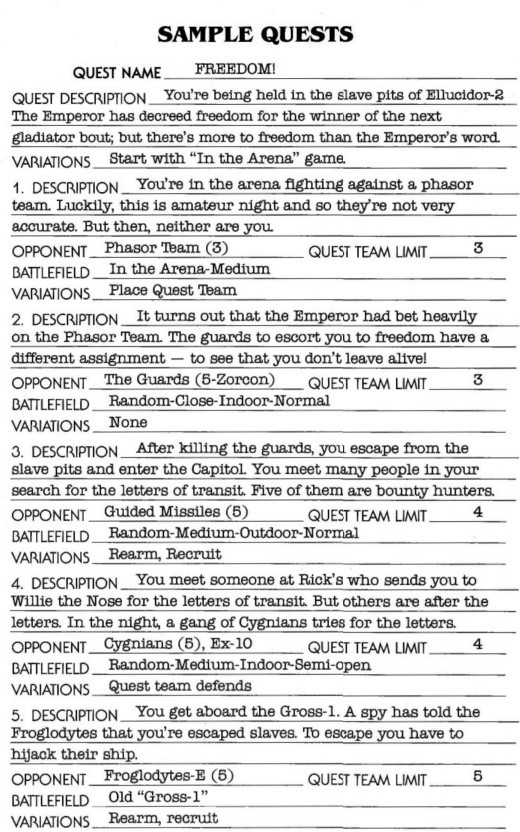
The second oddity is that the game races are nothing you’ve seen before. Except the humans, I guess :
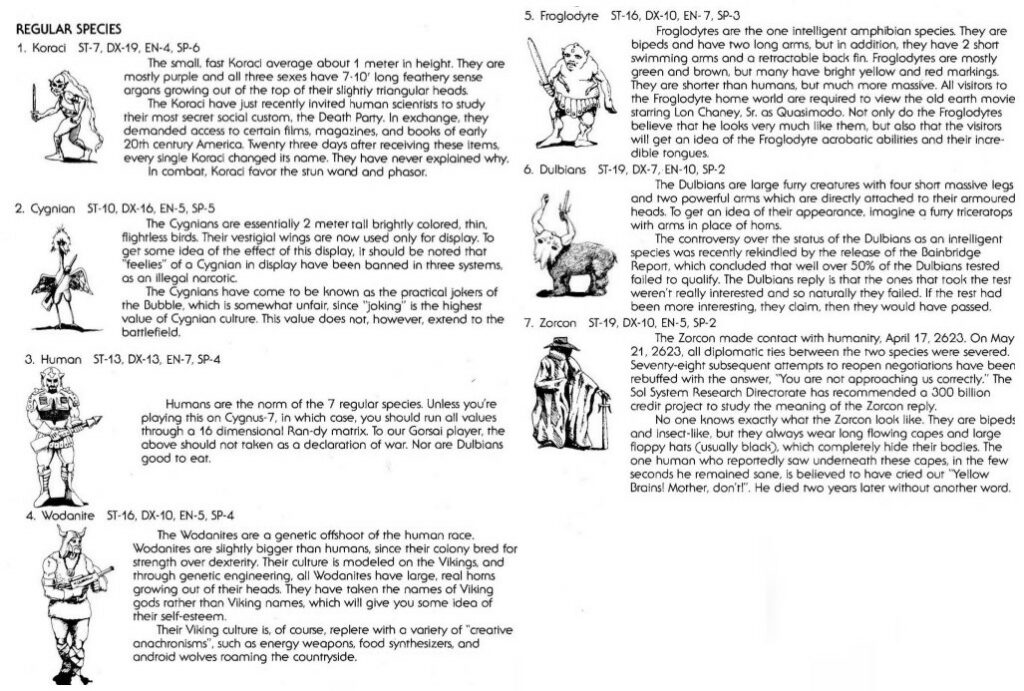
As weird as the descriptions are, there are in practice only 4 statistics to differentiate the 7 races :
- Strength doubles as HP, and determines both throwing range and what is the heaviest weapon a character can carry. It has no direct impact on the amount of damage dealt, but weapons of a given type (range or melee) have a linear progression. For instance, a Cygnian can at best carry a laser sword which inflicts 6-10 damage on a “full hit” (critical hit), whereas a Zorcon can carry a heavy disruptor which inflicts 12-16 damage.
- Dexterity is initiative (higher dexterity plays first) and chance to hit (the base chance to hit is dexterity x 5%, then one must add or remove various factors, including weapon skill),
- Endurance is how fast a character gets tired. It is drained by 1 every melee attack, so characters with ranged weapons don’t care about endurance,
- Speed is the number of tiles a character can move if it spends a turn moving (“move & move”). If they move & attack, or move & dodge, then they will go at half speed,
I don’t like designing scenarios and teams for the AI, but the game is so close to a tabletop RPG (one with mostly action, of course), that I felt it was a perfect game to be played by commenters, with me as a sort of gamemaster, either playing or letting the AI play, so it is exactly what I organized on my forum.
So, what’s the story there. The Koraci “Captain” Grimloc stole blueprints from whichever imperial office he was working in. But the blueprints were stolen from him shortly thereafter. After various encounters, he and a bunch of allies he made on the way located the blueprint on a starship, whose access is blocked by some guards who need to be removed.
There are 7 players, and each player chose a different race, so they would not be out of place in Mos Eisley Cantina.
The most powerful characters are also the lightest: “Captain” Grimloc and Baud :
- As a Koraci, “Captain” Grimloc is part of the weakest race in the Galaxy. With only 8 in strength, he cannot carry any armour and is likely to be killed or maimed on the first hit (a character is “wounded” and out of combat at 3 strength/HP). On the other hand, throughout the previous battles, he became an expert in long-range phasor : 8 in skill. Sounds like he has been chasing after these blueprints for a while! This gives him a +40% chance to hit (on top of an extreme dexterity giving a starting 95% chance-to-hit at point-blank range) and a 35% chance to deal a critical hit.
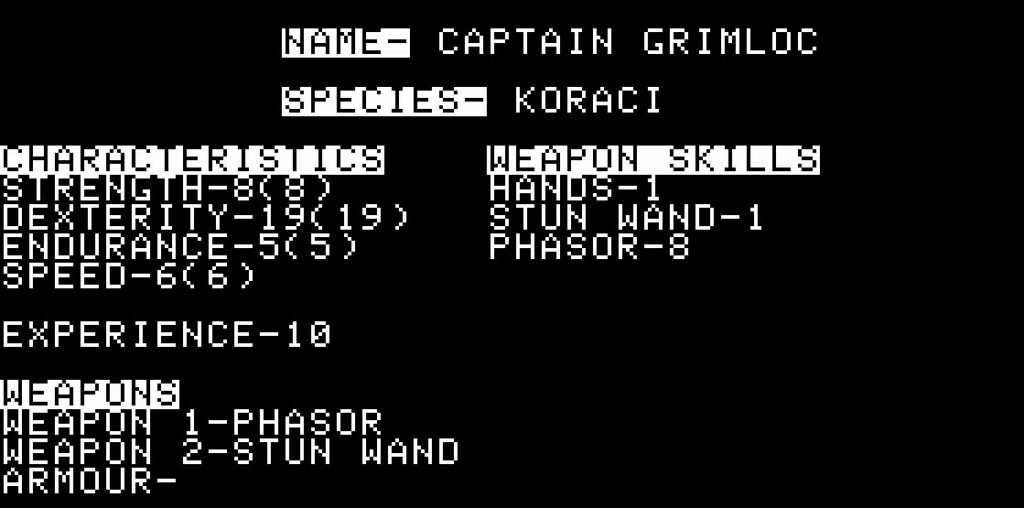
- Baud, a Cygnian, took the risk of choosing a career in melee combat despite low HP and so far it paid off handsomely. He improved his skill to 8, which also gives him +40% hit chance and 35% critical chance, on top of a 75% base hit-chance coming from dexterity. Much like the majestic swan his species takes after, he solemnly and smoothly floats across the battlefield, but under the water its little swan feed are paddling like crazy to keep up.
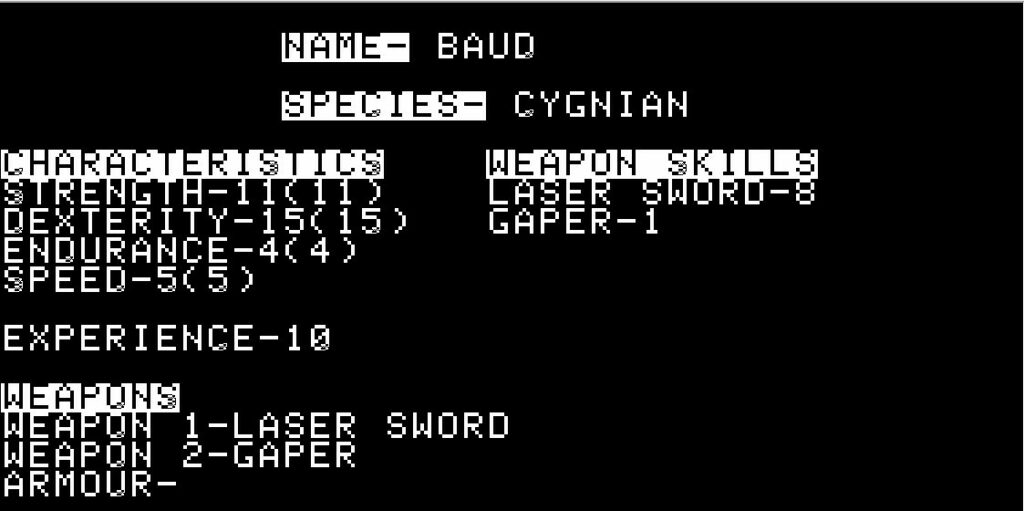
The team also has 2 heavy characters: they are slow, clumsy, but with 20 strength/HP they can take quite a few hits for the team.
- Rutus Trump, a Dulbian, equipped with a heavy disruptor (the most powerful melee weapon). Sadly, his low skill (4) and low dexterity (5 due to his armour) means he only has a 45% base chance to hit. Having biceps for horns has gone to this reindeer-like creature’s head and he intermittently rehashes dreams of grandeur.
- Andnjord, a Zorcon, whose even worse skill with his heavy disruptor (skill : 3) is compensated by his marginally better dexterity (6 due to his armour) and his flamboyant sense of fashion.
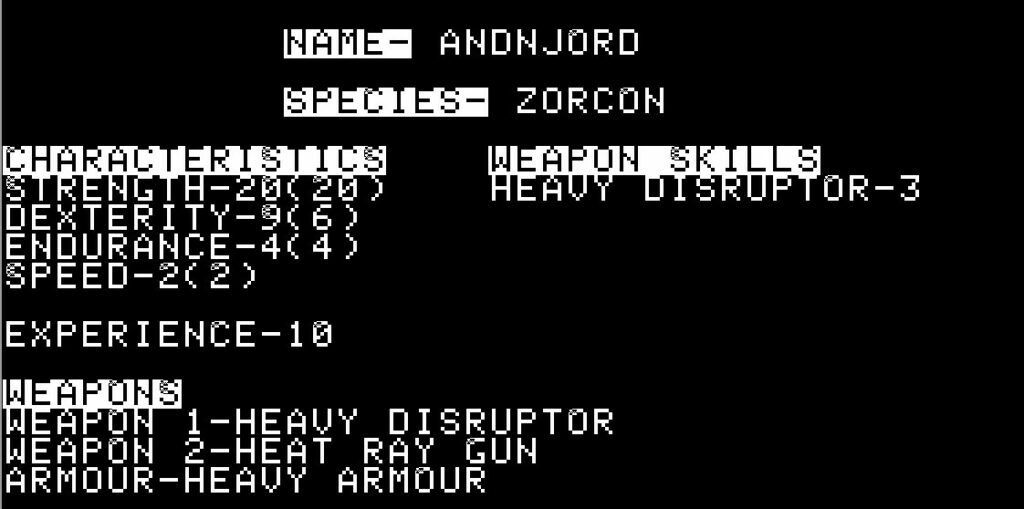
Finally, between those two weight classes, three players :
- Fellow, a Froglodyte with heavy armour, a phasor rifle (more powerful than a normal phasor), a gemstone (a sort of aiming frag grenade) and a keen acumen for exploiting the
meatshieldsother players’ strategic positioning. - Skosveinn, a Wodanite who decided to equip two gemstones. Once both are thrown, he will have to fight with his bare hands. Not that he has any problem with that!
- Porkbelly, the human latecomer, without any experience. To compensate for his lack of weapon skill, Porkbelly decided not to don his armour, so his dexterity would not receive any negative modifier. Actually, the player told me he removed everything, just in case.
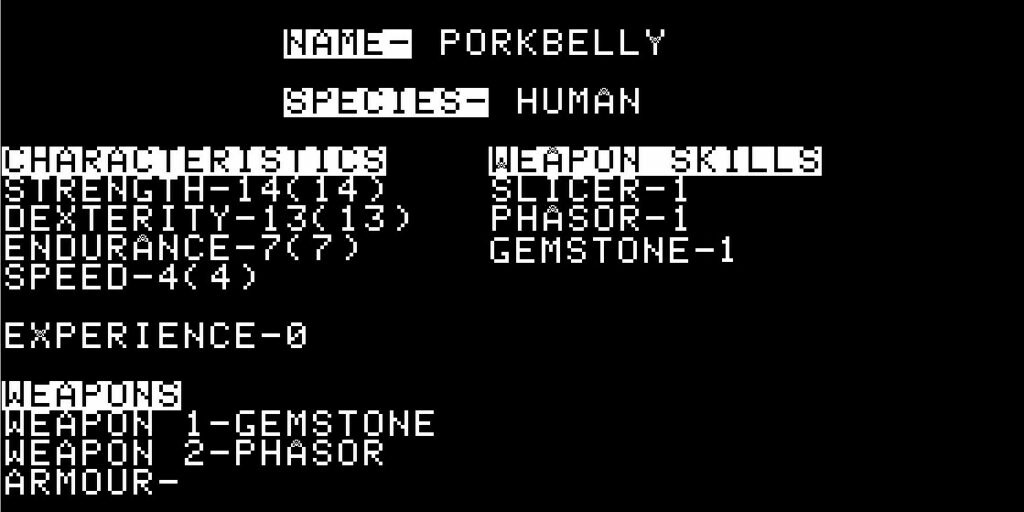
The reason for the discrepancy in weapon skill is that you only have a chance to improve it when you hit a target, so characters with high dexterity improve much faster than the other ones.
The opposition, fully controlled by the AI with no input of mine will be :
- 1 elite human with a phasor and a melee weapon,
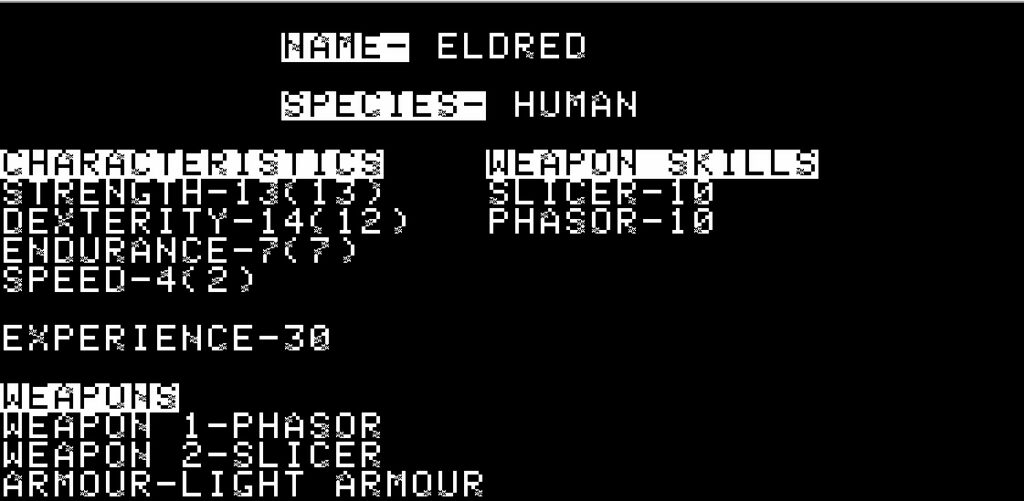
- 3 somewhat trained mobsters (2 humans and 1 froglodytes ; two of them with gemstones),
- Two robots. Lowish combat skill, but defensive juggernauts. The robots are some of the “irregular” species and their special power is that they are immune to non-critical damage (except coming from explosives),

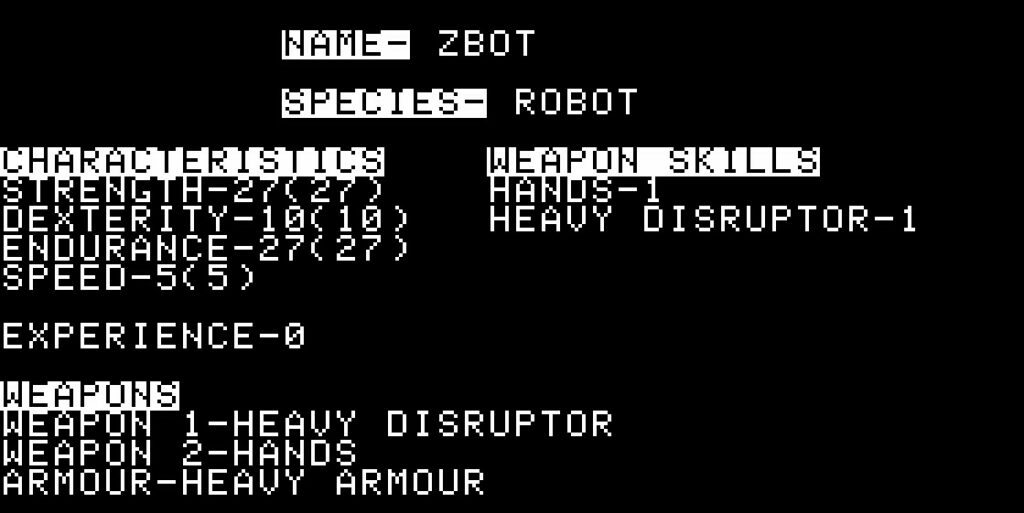
And with that, the fighters are deployed. Neither side achieves surprise (=free turn) :
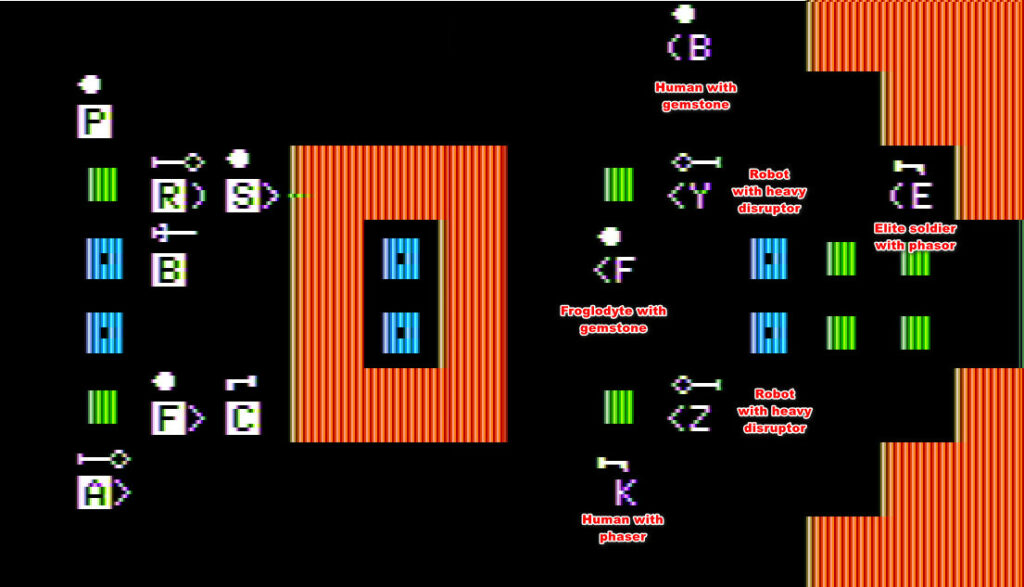
The game has 8 actions available :
- Standing Attack (whether melee, range, or thrown weapons)
- Double Move,
- Move & Dodge (-15% chance to be hit)
- Move & Attack
- Reload a phasor (it takes a full turn, and a phasor can be shot only once before needing to be reloaded),
- Swap weapon (each character has 2 weapons),
- Rest, and recover one endurance,
- Use the Heat-Ray Gun, a tool that destroys obstacles, but without effect against enemies – not in this scenario,
All the standing attacks are resolved first, in order of dexterity, then the movement, weapon-swap, reloading and resting, and finally the attacks after movement, again in order of dexterity.
In this case, it does not change anything, because the players turtle down and expect the AI to come to them, except the AI does not cooperate and just shoots at them from the other side, wounding Porkbelly.
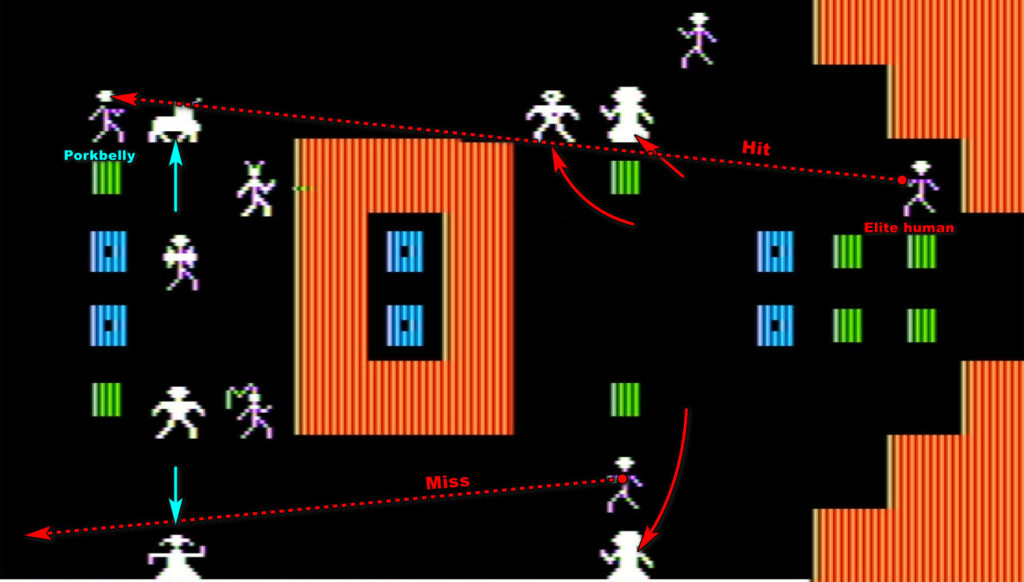
“Improvise, Adapt, Overcome”, the players immediately adapt their strategy, and decide to come out of their cover and attack. Skosveinn throws his first gemstone, and so does one of the AI grunts.
Gemstones are devastating weapons, automatically causing a powerful critical hit if landing on top of a character – so powerful it would be an instant game over for “Captain” Grimloc, Baud or Porkbelly- and still doing some damage if landing one tile away. They also tend to veer away from their intended target, sometimes landing on the feet of their throwers.
In this case, both miss their intended targets :

After those two standing attacks/throws are solved, it is time for movement, and then attack :
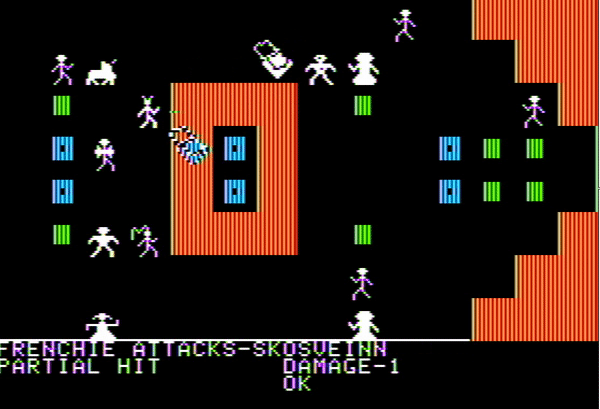
The hostile human at the bottom of the map receives 6 damages from “Captain” Grimloc, inflicting a heavy stun. A normal stun interrupts any action for the turn, a heavy stun also paralyzes the character for the following turn. A stunned character is also much easier to hit, as they cannot use their melee weapon to parry,
The players at the bottom press their advantage the following turn, with Fellow launching his gemstone. Bullseye !
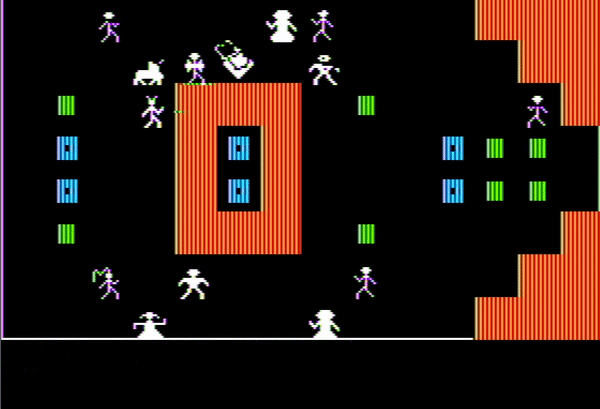
The robot is stunned and loses 10 HP, one of the trained humans, wounded the previous turn, is disabled and removed from the game. This might be the decisive action…
… and this is just as well, because at the top of the map, Porkbelly is hit again by the sniper, while a gemstone lands so close to Baud that he receives a grievous wound and a heavy stun. With 5 HP left and a “disabled” threshold at 3 HP, he is at risk !
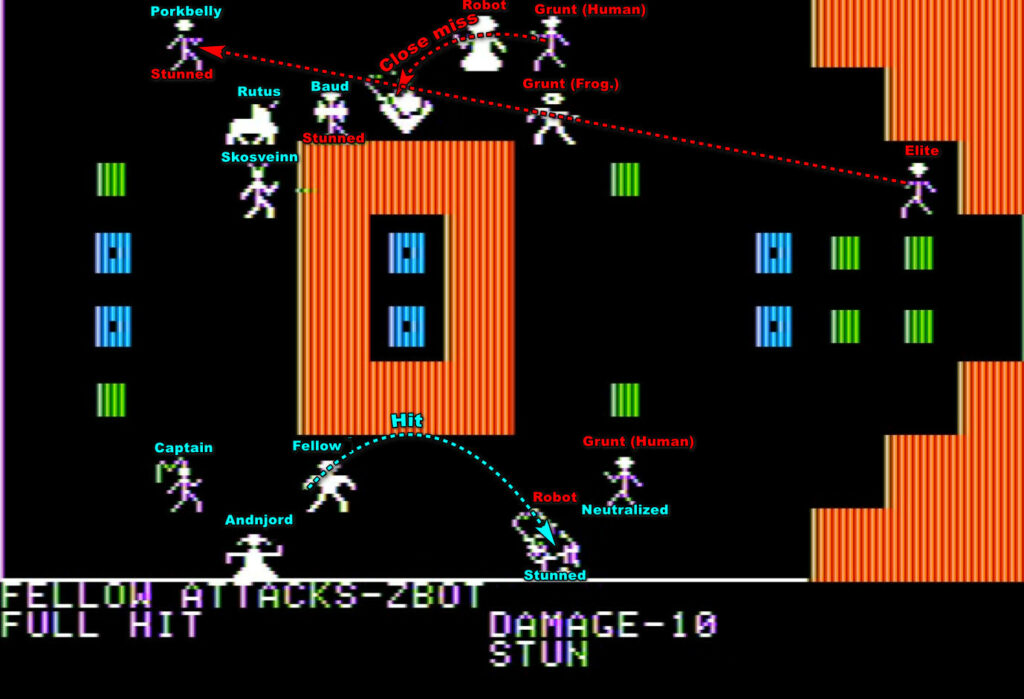
The following turns are a disaster for the team. Skosveinn’s last gemstone fails to make a difference as it lands on an empty cell, and Porkbelly is shot down a third time by the sniper in the back – disabling him. That leaves a wounded Baud and Rutus against a trained Froglodyte, a robot… and a sniper hitting his target every other turn !
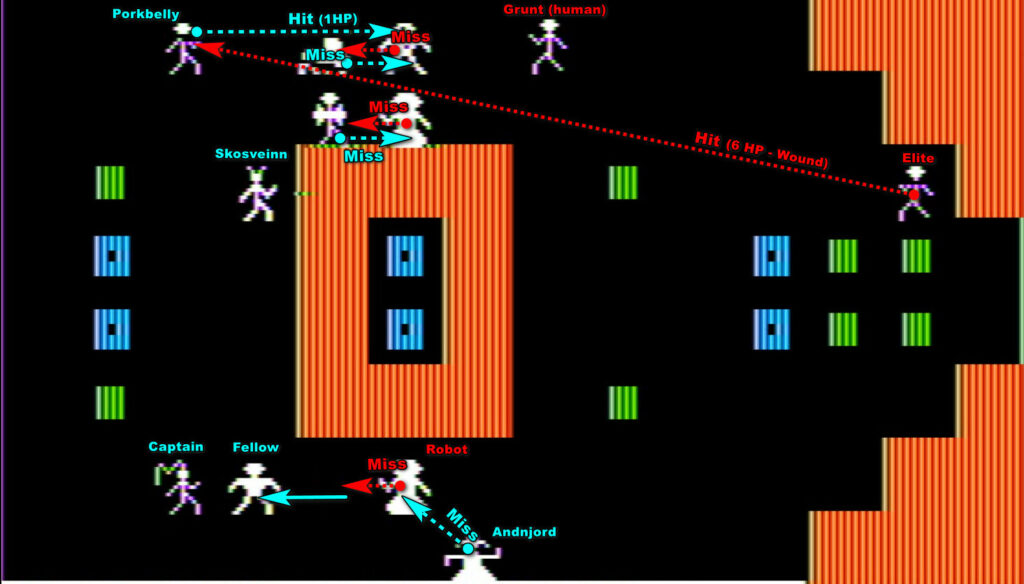
The players’ only hope is at the bottom of the map : they need to get rid of the robot as soon as possible, but only “Captain” Grimloc has a reasonable chance to damage it further. With only 3 in disruptor skill, Andnjord has only a 10% chance to cause a critical hit… provided he even hits the robot in the first place. Fellow has pretty much 0% chance to do anything by my calculation.
The team is saved by the AI’s poor prioritization. Instead of focusing its attack at the top of the map on the grievously wounded but dangerous Cygnian (Baud), they focus on the sturdy but ineffective Dulbian (Rutus Trump). The human grunt also remains in the back, not assisting the robot at the bottom of the map, and eventually the robot at the bottom is disabled !
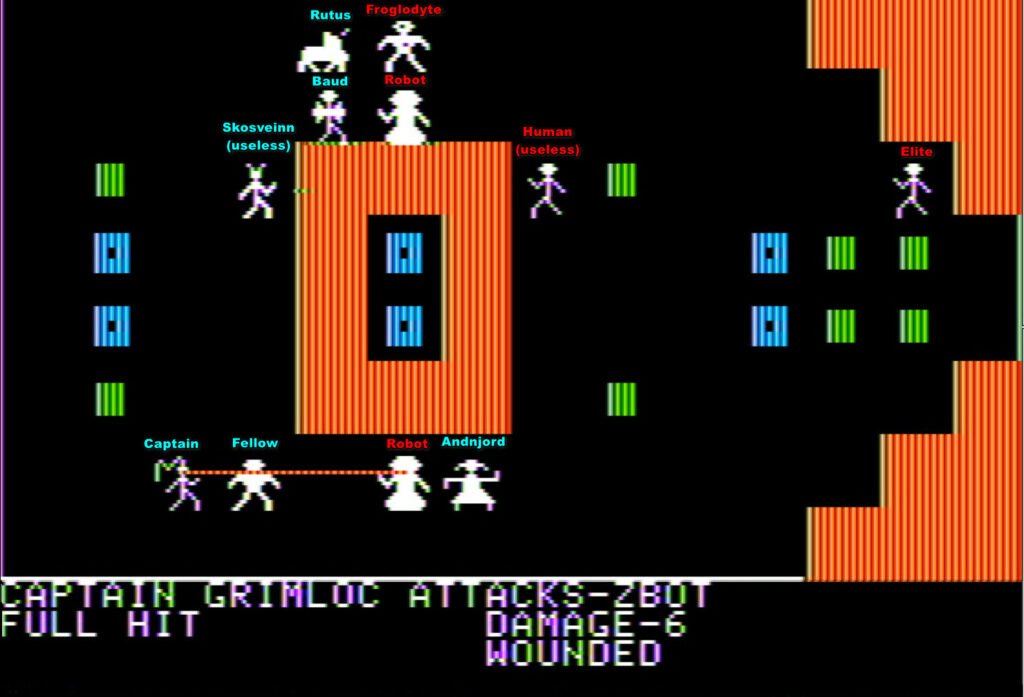
Just in time, Rutus receives a devastating critical hit from the sniper, and he is under heavy stun effect. Now a sitting Dulbian, his last HPs are drained the following turn by the robot.
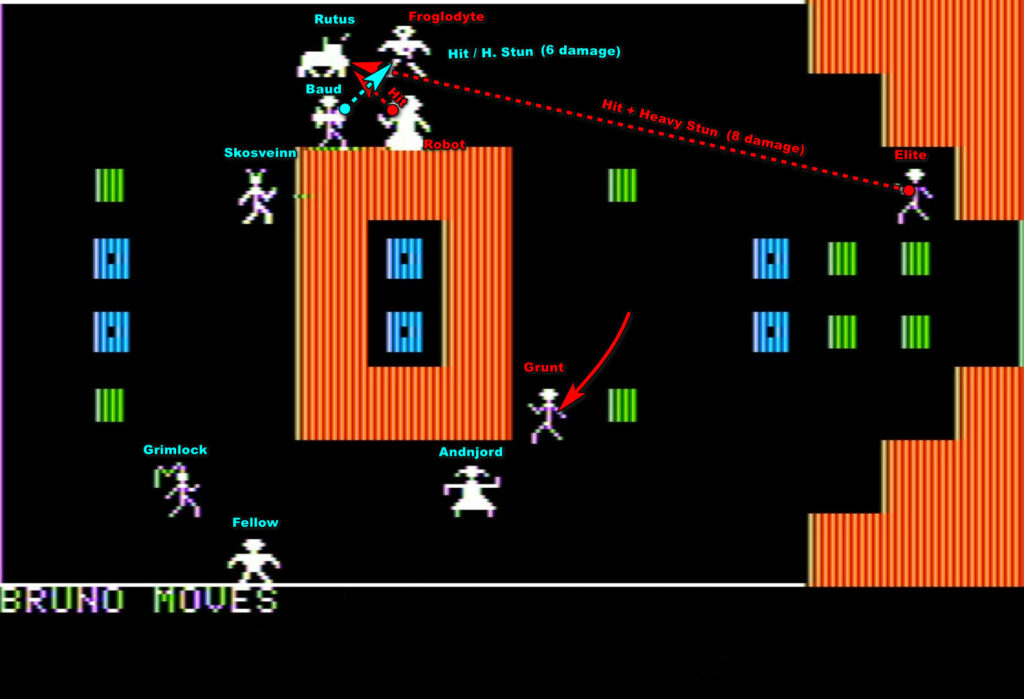
On the other hand, the last grunt’s attempt to stop Andnjord ends poorly for the enemy :

“Captain” Grimloc moves to the top of the map to destroy the second robot, while Skosveinn fills the gap left open by Rutus. He cannot hope to wound anyone with his bare fist, but at least he can make sure the AI focuses on him rather than on Baud.
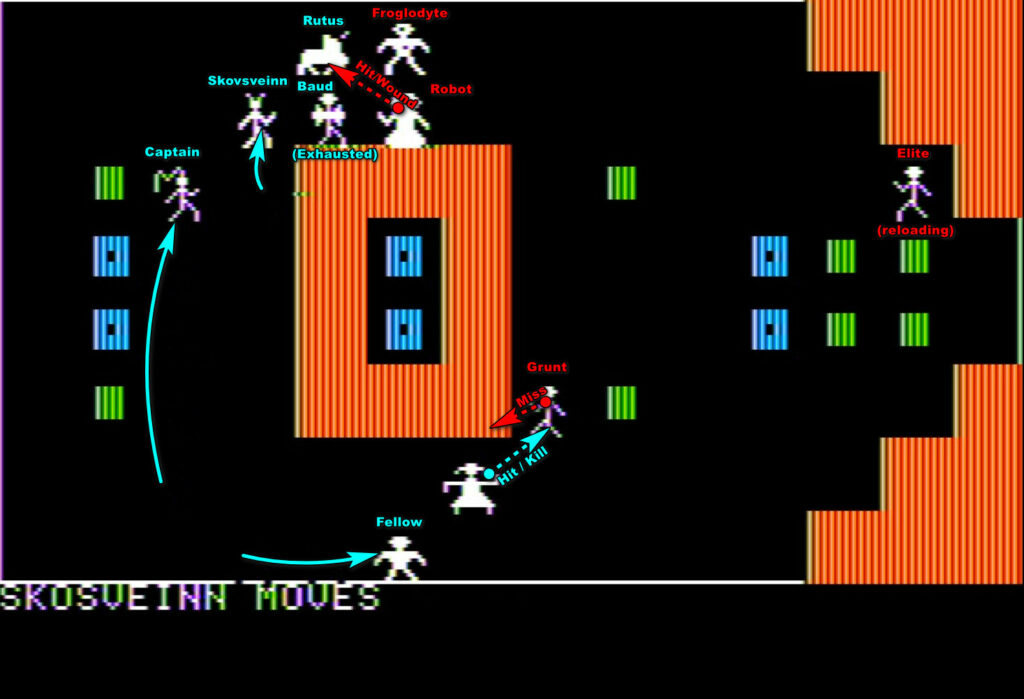
At this point, Baud, Andnjord and the Froglodyte are exhausted, and only attack every two turns. The robot, on the other hand, has never felt better.
Still, at 5 against 3, the situation is favourable to the players, and the AI knows it :

It improves even further when the combined attack of Captain Grimloc and a slightly rested Baud disables the Froglodyte turn 13 :
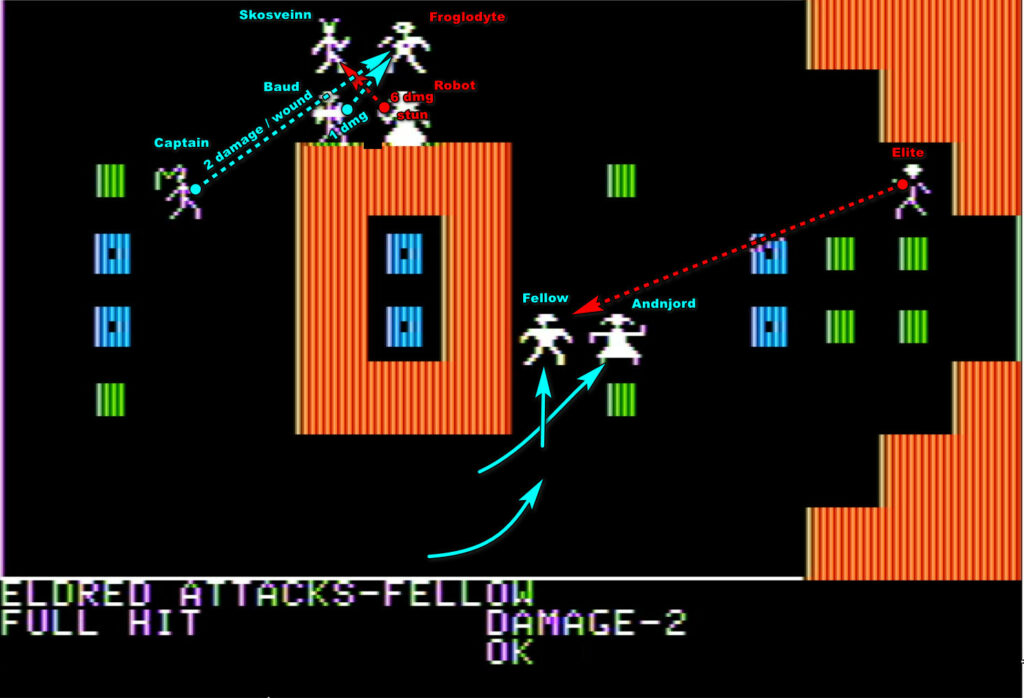
The situation is desperate for the AI, and it knows it :

Still, between Baud exhausted, “Captain” Grimloc needing to reload every other turn and Skosveinn fighting with his bare hands, the remaining robot has the time to hit its target (Skosveinn) again and again, until, turn 18 :

Meanwhile, Andnjord charges the elite human in melee, even hitting him once.
The human swaps weapons, and from the moment he can defend with a weapon, he forces Andnjord to attack with a -50% chance to hit. Andnjord is quite simply overmatched, and eventually :

It is at this moment that “Captain” Grimloc and Baud finally disable the last robot :
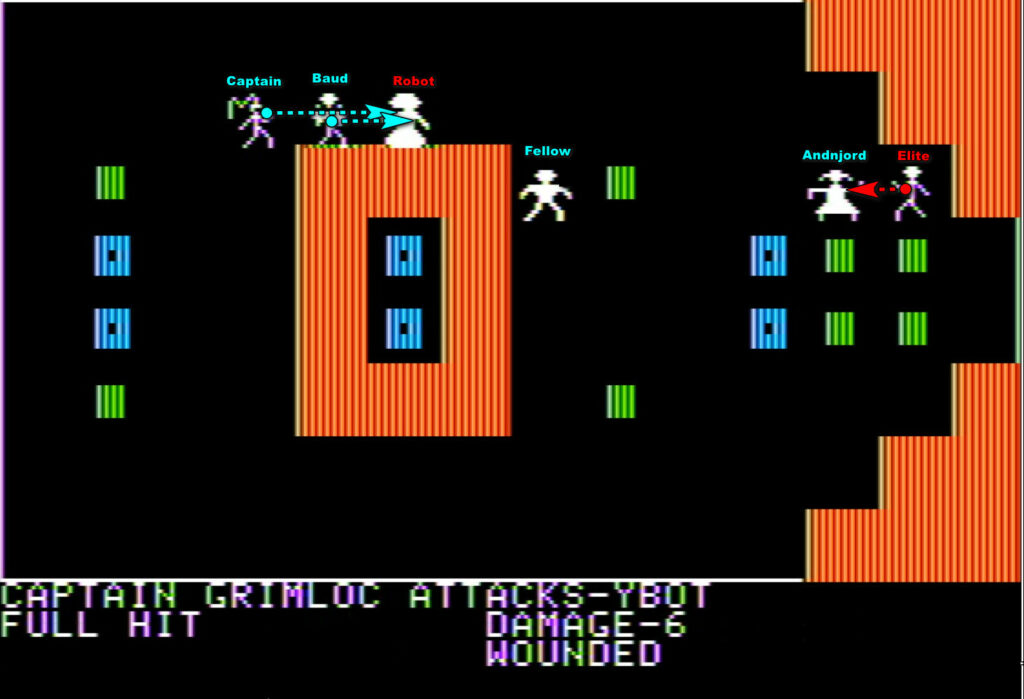
“Captain” Grimloc reloads and Baud rushes to support Andjnord, but not fast enough to save him !

Still, that’s the last casualty. Once “Captain” Grimloc has reloaded, no one can dodge his pinpoint accuracy :
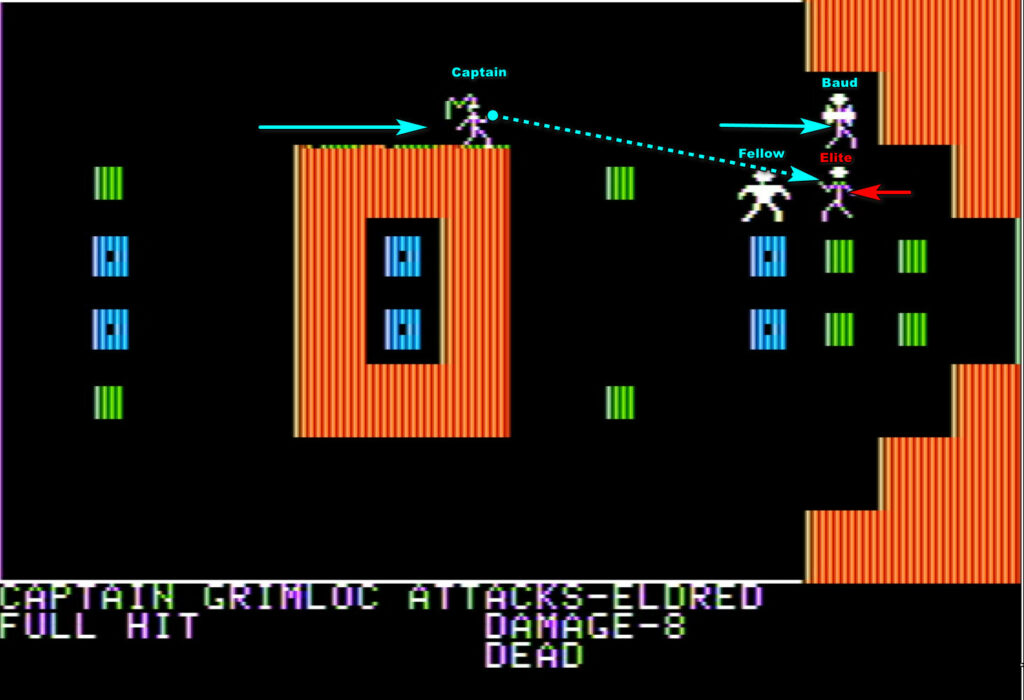
The battle has ended :
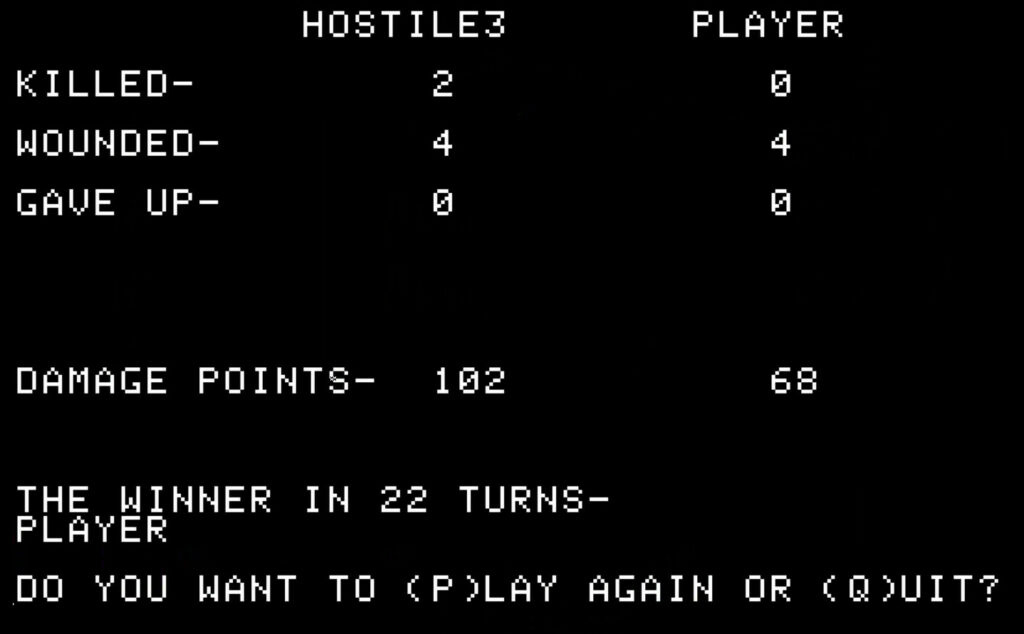
The game distinguishes between dead (removed forever from the game) and wounded characters (will be back with full HP in any future battle). None of the 7 characters of the team died in the battle, and they are in a good position to recover the blueprints from the ship, and hand them to their customer… What could go wrong now ?
Rating and Reviews
Galactic Gladiators, by Tom Reamy, published by SSI
First release : July 1982 on Apple II
Tested on : AppleWin emulator,
Total Hours Tested : 5 hours
Average duration of a battle: 30 minutes
Complexity: Easy (1/5)
Would recommend to a modern player : No
Would recommend to a designer : No
Final Rating: Well designed, but obsolete
A. Immersion
The game has some sort of backstory, but just like the race description it is mostly non-sensical. The player is playing a 20th-century version of a 28th-century combat simulator, and no it does not make much more sense in the manual :
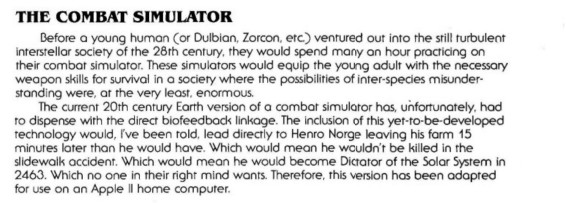
The manual also explains why melee weapons are so ubiquitous and why ranged weapons can only be used once before needing to be reloaded. It also explains why there are no stray bullets, too : you see the phasers use tachyons that attune the phaser to the nervous system of the target and then <vague hand gestures> you know. Tachyons.
All the races are goofy. Tom Reamy told me he had no inspiration in particular, instead choosing to pick some elements of Star Wars here, Lords of the Rings there, and other random fantasy books as they came.
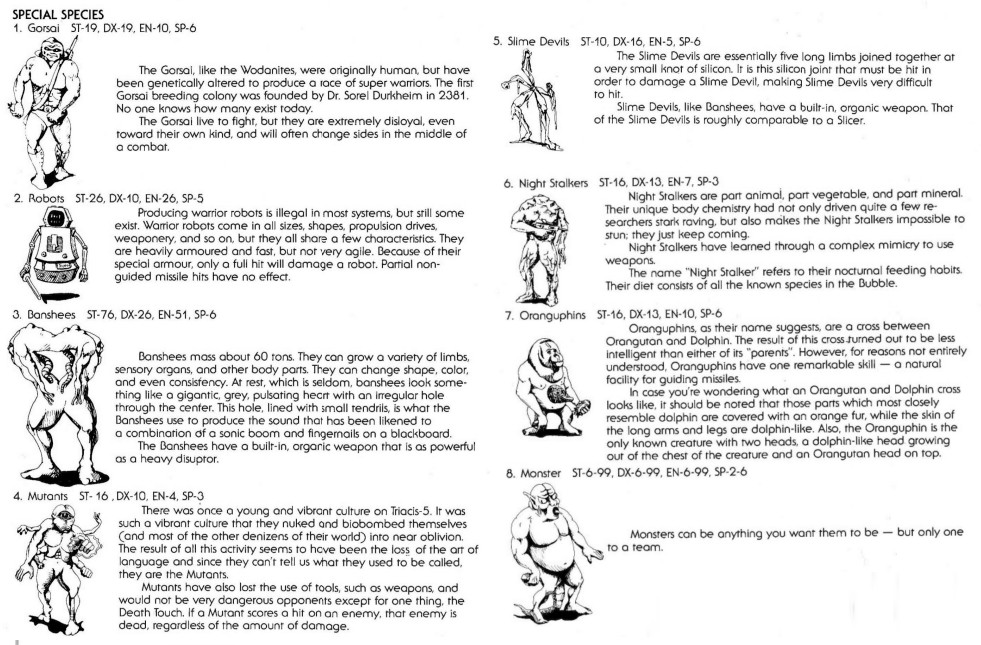
Rating : Ridiculous ! No, really, the only thing I can say is that it punches above its weight.
B. UI , Clarity of rules and outcomes
The manual proposes a tutorial scenario, a 3vs3 battle that takes no more than 5 minutes and will teach you everything you need to know. But even without this tutorial, Galactic Gladiators is easy to pick up and an absolute pleasure to play. The ruleset is deep, yet intuitive. Calculations are trivial to do on the fly (Each skill point ? 5% chance to hit. Each tile in distance ? -5% to hit, …) with the only exception of cover impact. All the information you may need is at worse two keystrokes away from you, and during turn resolution, you receive all the messages you need, and no extra message you don’t care about.
Of course, in a modern game, you would see health & fatigue bars, chance-to-hit appearing when you hover your mouse on your target or a clear indication on whether a weapon is loaded or not, but I feel like Galactic Gladiators includes the best that the 1982 technology offered.
Rating : Very good
C. Systems
It was strange to play a 1982 tactical game with the two-impulses (the first impulse being a movement, second impulse a movement, an attack or a dodge) system that I thought had been introduced in video gaming by the 2012 XCOM – Enemy Unknown.
There are a lot of things that work perfectly. The fact that standing attacks are resolved first and that “stuns” interrupt all character action gives the player a meaningful choice every turn. There is a system of zone-of-control : when next to a foe, a character can only move by one tile, which also means that a hostile “move & attack” will never hit empty air if the attacker moves to the tile occupied by its target (if the target moves one tile away, the attacker will follow, if not, the attacker will remain in place and still attack).
The system creates more meaningful decisions with armour. It absorbs a LOT of damage (4 for the heavy armour, keep in mind the most powerful weapon deals 6-8 damage on a non-critical hit), but the price is hefty : 3 in speed and dexterity for the heaviest armour, which means :
- an armoured character is likely to attack last (with a higher chance to be stunned before they can move),
- an armoured character has a -15% hit chance (for a chance to hit of 50% at best for a character strong enough to carry such an armour),
- an armoured character is more likely to be shot down before it reaches melee in large arenas, especially since each tile of movement in a turn decreases the chance to be hit by 5%),
I find this a very interesting choice to make when you equip your character.

The game has its flaws, by order of magnitude :
- I find the “no movement while swapping weapons” punitive, due to this rule characters seldom swap weapons, except after throwing a gemstone or a gaper, so they become ultra-specialized,
- Armour choice is interesting, but on the other hand all weapons of a given category (range or melee) are on a linear curve of power – for instance no weapon is faster, or more accurate :
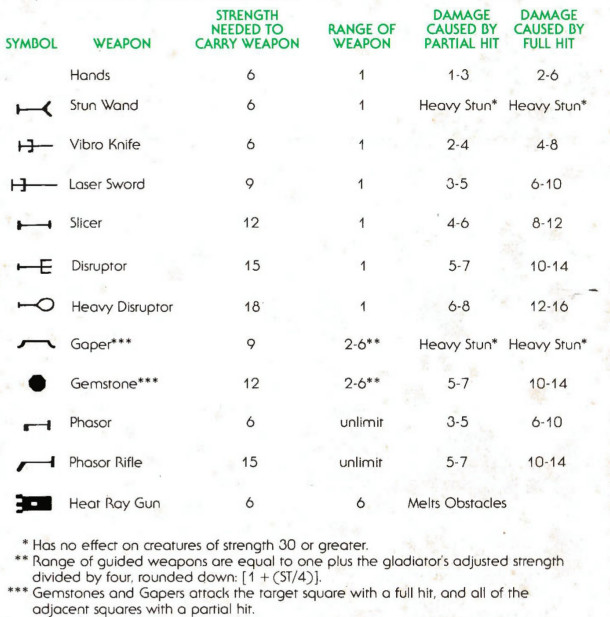
- Weapon skill can only increase when you successfully hit with one, which means characters with high dexterity will improve extremely quickly, unlike the low dexterity character who will keep terrible weapon skills for several battles. For instance, Rutus and Andjnord have participated in 3 battles, but their weapon skill was still at respectively 4 and 5 after that. Fellow systematically used his phasor rifle after launching his gemstone, but remained at 1 in phasor rifle skill.
As the campaign goes on, the gap progresses, which means your team is split between players with more than 120% base chance-to-hit and players with 40% base chance-to-hit. Add to this that high melee skill allows you to parry enemy attacks, including ranged attacks (by 5% by skill point), and you quickly find yourself in a situation where hostile characters are either impossible to hit by some of your characters, or just too easy to hit by the other characters.
Rating : Good
D. Scenario design & Balancing
In Galactic Gladiators, you must design the scenarios, either on your own or based on the campaigns proposed by the manual. As I explained in my review for the Cosmic Balance, I don’t like that very much : “did I beat the AI because I played better or did I gave them a terrible team composition”.
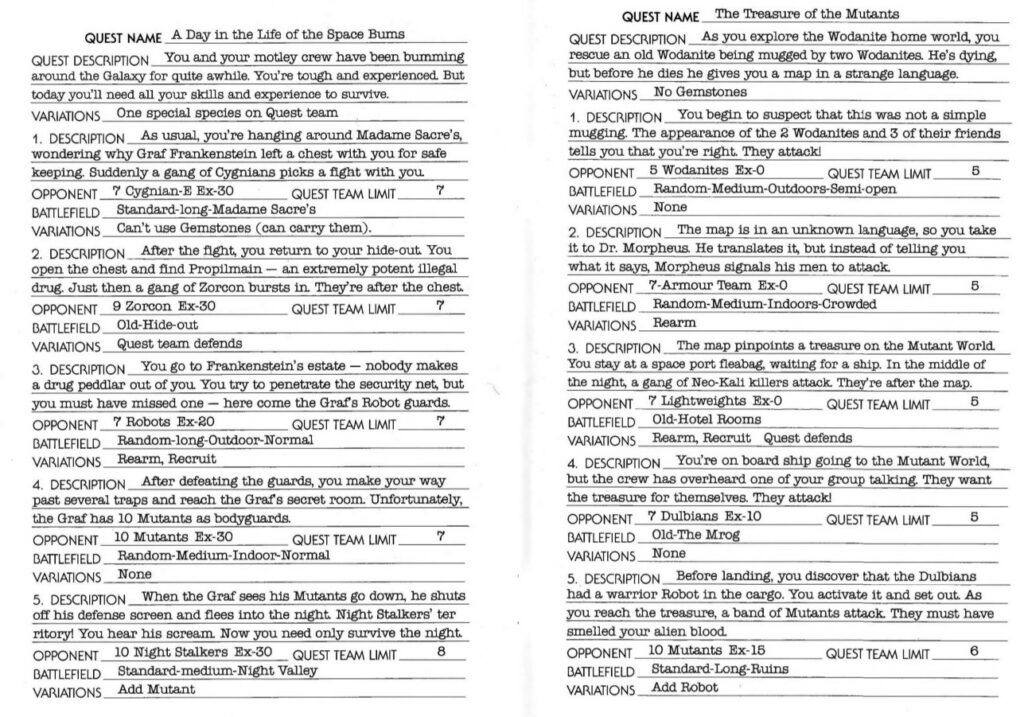
You have a lot of tools for that, you can create teams of any size or any composition – and the bestiary is diverse enough. There are a lot of choices on the battlefield as well : they can have 3 different sizes (the one of the AAR was the smallest possible size), you can pick them among an extensive list, or generate them randomly, or even create them yourself manually :
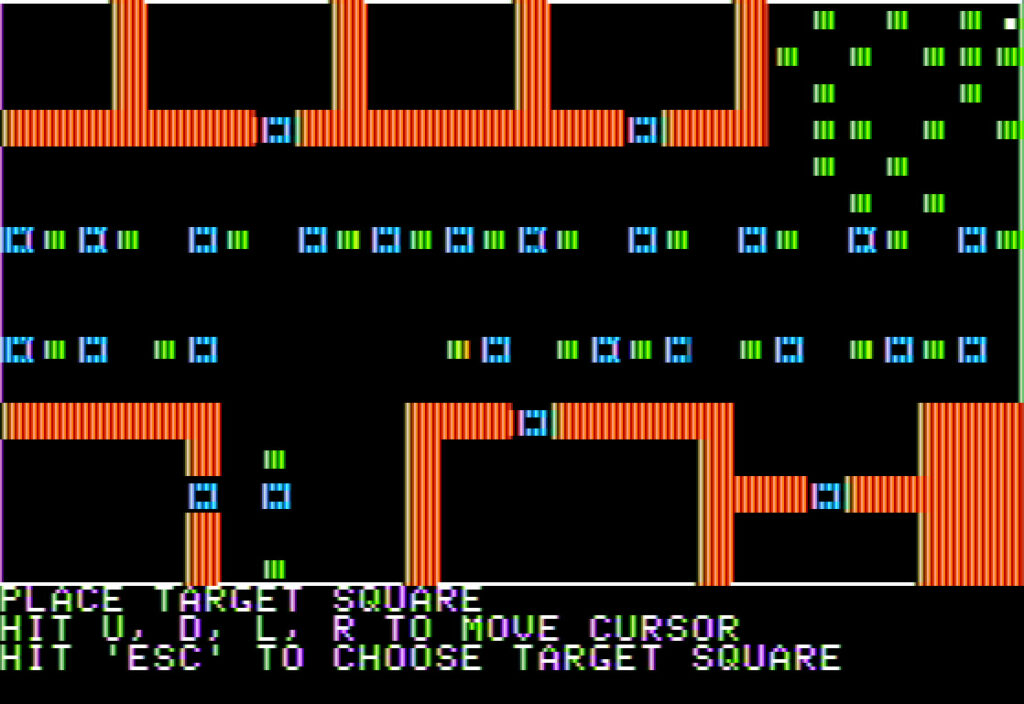
There are a lot of preset teams of all species, two different objectives (control, and occupy key points). You can even create complex scenarios by manually positioning the AI characters at the beginning of a battle, or taking control of the AI at any moment.
After your first battles, you will want to play a campaign, which means increasing the level of the opposition as the campaign goes on. And that’s when you will realize the game has a terrible flaw : you don’t have the tools to upgrade the opposition. In particular, you cannot create characters of a specific skill level : characters are either at the lowest level of skill, or “elite” (with 10 in all skills).
The frustrating part is that Tom Reamy knew about the issue as he mentions it in the manual. The “solution” he proposes is to generate novice enemies, then manually play battles with them (as a “two-player game”, so you get the result you want), and level them up that way. This is time-consuming enough with a modern emulator, I can’t imagine how frustrating it must have been in 1982. And if you want to generate a team of 5 or 7 “trained” characters, it will take 2 if not 3 fake battles … exactly the reason for which my players only encountered 3 trained grunts. For a game based around campaigns, I see that as damning.
Final note : the AI is particularly weak, moving its characters in loops and often prioritizing the worst possible target (for instance the unharmed and useless Skosveinn in my AAR) – the manual even suggests having 2 more AI characters than player characters.
Rating : Very poor (as a single player experience)
E. Did I make interesting decisions
Yes, especially at the beginning of a battle ; once a character is engaged in melee there are not that many different ways to stab or to club a target.
F. Final rating
Well-designed, but obsolete. Another very difficult rating to give : the game is one of the best games I encountered for its ruleset, it feels from this point of view years ahead of its time, but the progression is broken, and it is so hard and frustrating to create scenarios that it cannot sustain interest nowadays as a single-player experience – hence the obsolete rating.
I cannot stress this enough : I had more fun with this game than with any other game I covered so far, but only as a game master of a role-playing game of sorts . In single-player, I did not want to invest more time in it after less than 2 hours ; as creating the scenarios was taking an increasing amount of time, and I was never sure I had balanced the game properly due to the weapon skill difference between my characters.
The issue was well-understood by either Tom Reamy or SSI, and the game had a sequel in 1983, called Galactic Adventures, whose purpose was to “create scenarios for Galactic Gladiators“. But the game leaves the “tactical game with RPG elements” territory and steps in the “tactical RPG” one so the CRPG Addict covered it and shared my opinion that the game was trailblazing.
If I had, I would have played this game early, and would have seen what is probably SSI’s first fusion of strategy game and role-playing game. I would have referred to it when analyzing the combats in Wizard’s Crown, Shard of Spring, and Pool of Radiance, and I would have been giving Tom Reamy credit for introducing this kind of combat mechanic into the CRPG genre for the first time.
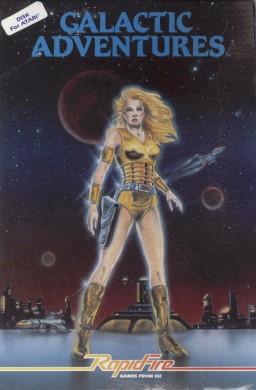
Contemporary Reviews
In August 1982, immediately after the game is released, Softtalk starts its review with “Amazing ! Amazing ! […] This game combines the good parts of absolutely every other computer wargame, all the simulations, and all the role-playing games available on the Apple Market”. After the review itself, just to make sure that you got the message, the reviewer concludes “Galactic Gladiators is simply a masterpiece […] It will continue to be interesting when your other game disks are gathering dust on the shelves”
Softline in November 1982 echoes the review, with Bob Proctor even expecting tournaments to take place, as the game “will be around for a while”. Similarly, Chris Smith reviewing the game in January 1983 for the Space Gamer is particularly impressed with simultaneous turn resolution and how fresh each battle is due to the number of different parameters: “No game is like another“.
SSI’s favourite Computer Gaming World was just as enthusiastic as anyone else. In September 1982. David Long called the game “easy to learn and fast to play […] but much like chess it will take a long time to feel you’ve mastered this game and the possibilities are endless“. One negative feedback though: the AI. It is “not as challenging as other SSI games”, Long even suggests reverting to manual control from time to time to help it. The same issue of Computer Gaming World even includes a scenario, based on the opening scene of Star Wars, though the article warns that AI will be disadvantaged in this scenario. In August 1984, the now two-year-old game would receive 3 more scenarios from Computer Gaming World.
Finally, even Electronic Games, rarely mentioned on my blog as it usually shuns wargames, allocates 5 high-quality pages to the game. Neil Shapiro praises pretty much everything and concludes with “Galactic Gladiators is just about the most versatile and open-ended of any computer game.” Later, the game somehow manages to be nominated in the “most innovative game of 1984” category, thanks to the timely release of its IBM PC port.
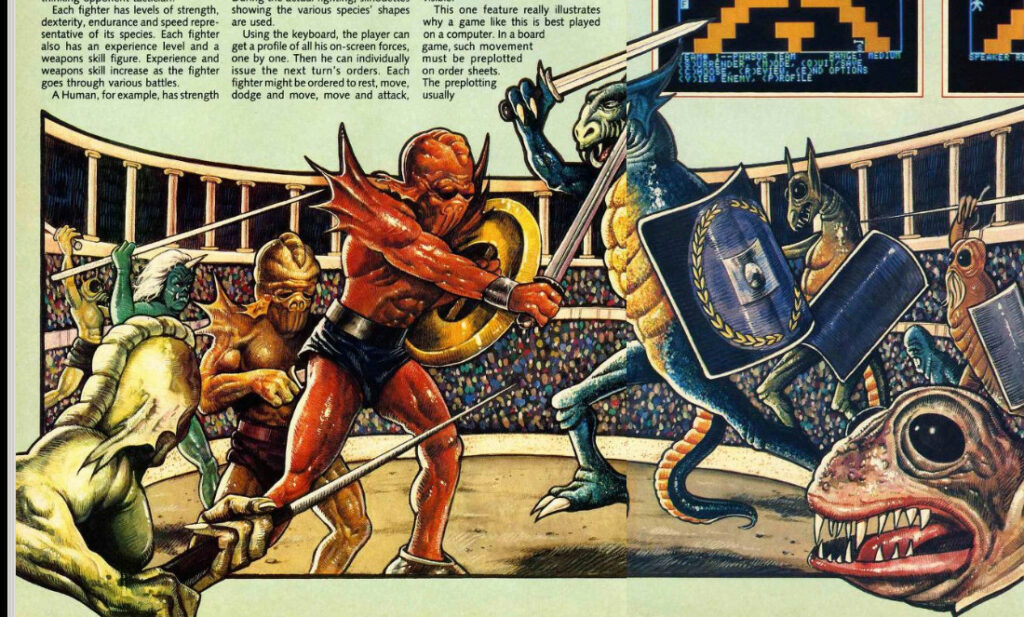
Even the never-pleased French people from Casus Belli liked the game ! Reviewing both Galactic Gladiators and Galactic Adventures in October 1983, Casus Belli starts by describing them as “strange games, both rich and frustrating“. But the review turns out to be long on the richness, and short on the frustration : the only “sore point” is the low-quality art.
I believe the only time I have seen reviews similarly so unanimously positive was for Chris Crawford’s Eastern Front 1941. So certainly, the game must have been a commercial success? Sadly, not really: only 4 700 copies were sold – not great, not terrible, and in any case way below SSI’s sports game or even the Warp Factor. Still, enough to justify a sequel : Galactic Adventures. Galactic Adventures being more of a role-playing game, I am not sure I will cover it with a full-fledged article, but stay tuned!
3 Comments
And it was extremely fun to play-by-forum as well. I DID pick a completely useless character tho….
This game was super fun to participate in. So glad we did this.
This game looks awesome!